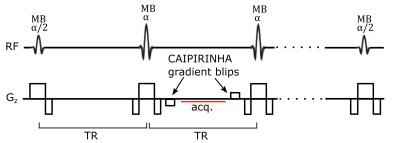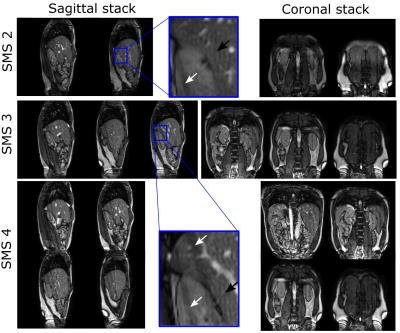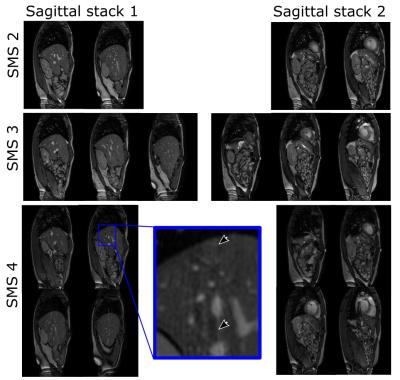5549
Using multi-stack simultaneous multi-slice bSSFP for improved motion characterization during MR-guided radiotherapyPim Borman1, Clemens Bos2, Sjoerd Crijns1, Chrit Moonen2, Bas Raaymakers1, and Rob H.N. Tijssen1
1Radiotherapy, UMC Utrecht, Utrecht, Netherlands, 2Imaging Division, UMC Utrecht, Utrecht, Netherlands
Synopsis
Integrated MR-guided radiotherapy systems make it possible to monitor intra-fraction anatomy changes due to motion. A Simultaneous Multi-Slice (SMS) balanced SSFP sequence with interleaved stacks is used for dynamic imaging, where SMS is used to increase the spatial coverage without decreasing the frame rate. It is shown that SMS factors up to 4 are feasible without significant artifacts, for both orthogonal and parallel stacks.
Purpose
The promise of integrated MR-guided radiotherapy systems1,2 is that mobile tumors can be monitored during the treatment and that the risk of radiating nearby organs at risk can be reduced. The high signal-efficiency makes balanced steady-state free-precession (bSSFP) an ideal candidate for real-time motion tracking. Previous studies have successfully demonstrated tracking of a tumor centroid using single slice acquisitions with interleaved orthogonal imaging planes3. In this work we propose a multi-stack, simultaneous multi-slice (SMS)4 bSSFP sequence, which allows real-time tracking of multiple independent locations (e.g., tumor and organs at risk). The interleaved nature of the sequence, however, may present a challenge for the use of bSSFP as interruptions of the steady-state may lead to transient artefacts and stacks with different orientation may introduce time-varying eddy currents. An initial characterization of these effects is performed in a phantom study and the in vivo image quality is assessed.Methods
A balanced SSFP SMS-CAIPIRINHA sequence was implemented on a 1.5T Ingenia scanner (Philips, Best, NL). To induce the controlled aliasing, slice-selective gradient blips were applied, that were balanced during every TR to maintain signal coherence5. Image acquisition allowed prescribing multiple stacks that were either mutually orthogonal or parallel. Each stack used a $$$\alpha/2$$$ MultiBand pulse to bring the spins near steady-state, and again at the end to bring the magnetization back to the longitudinal axis (fig. 1). The SMS images were reconstructed in MATLAB (MathWorks, MA) using ReconFrame (Gyrotools LCC, Zurich) and a custom SENSE unfolding implementation. Parameters further included α/TE/TR = 50°/1.85ms/3.7ms, FOV 394x450mm2, voxel size 2.34x2.34x8mm3, and signal was received using a 28-channel coil array. First, phantom experiments were performed in a 2% agar phantom. Two orthogonal stacks (coronal and sagittal) were acquired in an interleaved fashion with varying delays to assess the effects of eddy currents produced by switching gradient orientation. To test for transient artefacts additional scans with 100 dummy pulses were acquired and compared to the $$$\alpha/2$$$ only catalization. For the volunteer experiments, SMS factors ($$$R_{SMS}$$$) 2-4 were used to increase the number of slices per stack accordingly. The dynamic scan time was 1.2s and the slice gaps were 15mm. The orthogonal stacks (coronal and sagittal) were centered on a kidney, while the parallel stacks (sagittal) were placed one in each kidney.Results
The phantom experiments (fig. 2) showed ripple artefacts (black arrows) independently of the delay between the stacks while in the sequence with dummy pulses these ripples were absent. This implies that eddy currents of timescales <1000ms are unlikely to have affected the image, but that the artefacts are related to the disrupted steady state of the magnetization. The in vivo SMS images (figs. 3, 4) show that multi-stack SMS bSSFP is possible while maintaining adequate image quality to dynamically visualize anatomic structures such as kidneys, liver and spine. Apart from the expected saturation bands at the intersection of orthogonal slices (fig. 4), mild rippling due to transient effects can be seen in various locations of the images (fig. 3). SMS-CAIPIRINHA performed well for both orientations up to $$$R_{SMS} = 4$$$, with only minor unfolding artefacts present when four sagittal slices were acquired simultaneously (fig 4), indicating the parallel imaging limits of the receiver-coil array. These artefacts are consistent with the g-factor maps which showed high values (data not shown).Discussion
The combination of SMS with bSSFP provides an extremely SNR efficient multi-slice sequence, while the ability of acquiring multiple stacks in an interleaved fashion provides the flexibility to track multiple targets during the intervention. Although the real-time images do not need to be of diagnostic quality, the artefacts observed (e.g., saturation bands and transient artefacts) may have the potential to influence the tracking accuracy. We have previously demonstrated that saturation bands in single slice orthogonal acquisitions do not affect the registration accuracy6. Nevertheless, it is a topic of future research to confirm whether these results translate to multi-stack SMS bSSFP, where multiple saturation bands are present. The transient effects are small compared to the saturation bands and may be reduced by more extended catalyzation schemes tailored to real-time imaging7.Conclusion
We have implemented and demonstrated the feasibility of a multi-stack SMS bSSFP sequences, which allows the acquisition of 2 x 4 simultaneously acquired slices with minimal transient steady-state or unfolding artefacts. Future work will assess the tracking accuracy of this sequence in combination with real-time image registration or tracking algorithms.Acknowledgements
No acknowledgement found.References
[1] Lagendijk et al., Semin Radiat Oncol 24(3), 2014
[2] Mutic S et al., Semin Radiat Oncol 24(3), 2014
[3] Bjerre T et al., PMB 58(14), 2013
[4] Breuer FA et al., MRM 53(3), 2005
[5] Wang D et al., Patent US 20150115958 A1, 2014
[6] Stemkens B et al., PMB (61), 2016
[7] Santos JM et al.,Proceedings ISMRM (13), 2005
Figures

Figure 1: RF and slice gradients of the multi-stack SMS bSSFP sequence are shown.
The RF pulses are MultiBand pulses that excite multiple slices simultaneously.
The CAIPIRINHA gradient blips induce a phase difference between these slices
during readout, but are balanced afterwards to preserve the steady-state. Their
values change every phase encoding line, depending on the desired phase-cycling
pattern.

Figure 2: Images from the phantom experiment with SMS factor 2 and two
orthogonally interleaved stacks. The standard pulse sequence (left) is compared
with a sequence with a 1000ms delay between the stacks (center) and a sequence
with an additional 100 dummy pulses before each stack (right). Black arrows
denote transient artefacts.

Figure 3: Reconstructed SMS images with SMS factors 2-4 for orthogonally
interleaved stacks. The white arrows denote dark bands where the coronal slices
intersect the sagittal slice. The black arrows denotes ripples due to lack of
steady-state. The dynamic scan time was 1.2s.

Figure 4: Reconstructed SMS images with SMS factors 2-4 for parallel interleaved
stacks through each kidney. The dynamic scan time was 1.2s. The open arrows indicate regions with imperfect
unfolding, resulting in increased noise and artificial intensity variations.